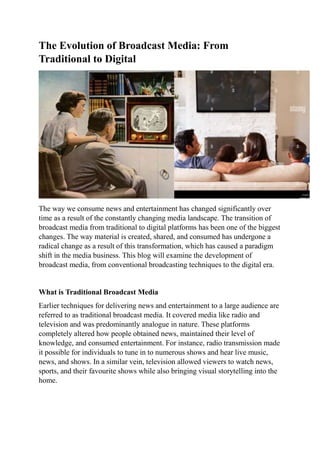
The Evolution of Broadcast Media.docx
- 1. The Evolution of Broadcast Media: From Traditional to Digital The way we consume news and entertainment has changed significantly over time as a result of the constantly changing media landscape. The transition of broadcast media from traditional to digital platforms has been one of the biggest changes. The way material is created, shared, and consumed has undergone a radical change as a result of this transformation, which has caused a paradigm shift in the media business. This blog will examine the development of broadcast media, from conventional broadcasting techniques to the digital era. What is Traditional Broadcast Media Earlier techniques for delivering news and entertainment to a large audience are referred to as traditional broadcast media. It covered media like radio and television and was predominantly analogue in nature. These platforms completely altered how people obtained news, maintained their level of knowledge, and consumed entertainment. For instance, radio transmission made it possible for individuals to tune in to numerous shows and hear live music, news, and shows. In a similar vein, television allowed viewers to watch news, sports, and their favourite shows while also bringing visual storytelling into the home.
- 2. Difference Between Traditional Vs Digital Broadcasting The two ways of distributing content to an audience are traditional broadcasting and digital broadcasting. With traditional broadcasting, content is distributed simultaneously to a large audience via a one-to-many strategy. The many-to- many paradigm is used in digital broadcasting, where the content can be distributed to both individual users and groups of people. 1.Delivery strategy: Content is simultaneously sent to a big audience through traditional broadcasting. With digital broadcasting, information is distributed to specific consumers or groups of people. 2.Media: Radio, television, and print are examples of traditional broadcasting's non-internet-connected media. Internet-connected media, such as the internet, mobile devices, and social media, are used in digital broadcasting. 3.Audience size: A huge audience can be reached through traditional broadcasting A more focused, smaller audience can be reached by digital broadcasting. 4.Content: Content for traditional broadcasting is usually pre-recorded or live. Content for digital broadcasting might be interactive, live, or pre- recorded. 5.Measurement: Nielsen ratings are used to measure conventional broadcasting. Analytics are used to measure digital broadcasting.
- 3. 6.Cost: Digital broadcasting generally costs less money than traditional broadcasting. The Rise of Digital Broadcasting The broadcast medium saw a significant change as a result of the digital revolution. The development of digital broadcasting platforms was a result of the fusion of technology and media. The switch from analogue to digital transmissions was one of the first innovations. Digital broadcasting provides better audio and visual quality as well as other features including interactive options and electronic programme guides (EPGs). The Internet and Streaming Services Broadcast media underwent a significant transition as a result of the internet's widespread use. The introduction of online streaming services transformed the distribution and consumption of content. Users may access movies, TV series, and original content on-demand thanks to services like Netflix, Amazon Prime Video, and Hulu, which do away with the necessity for conventional broadcast schedules. This change gave viewers more influence over their media intake, giving them more control over what, when, and how they watched. Social Media and User-Generated Content Another significant aspect of the digital evolution in broadcast media has been the rise of social media and user-generated content. Platforms like YouTube, Facebook, Instagram, and Twitter provided individuals with the ability to create and share content with a global audience. This democratization of media allowed anyone to become a content creator and reach a vast number of viewers. Consequently, social media platforms became crucial distribution channels for news, entertainment, and even live events.
- 4. The Effect of Mobile Devices and Smart TVs The rise of smartphones and smart TVs accelerated the transition to digital broadcasting. Users were able to stream information while on the road thanks to mobile devices with fast internet connectivity. This change not only increased the audience but also made viewing experiences more individualised. Additionally, traditional broadcasting and digital content were seamlessly incorporated into smart TVs with internet connectivity and built-in streaming services, blurring the lines between the two media. Steps involved in Traditional and Digital Broadcasting 1. Analog Broadcasting: Traditional broadcasting begins with the use of analogue technology, where audio and video signals are transmitted in analogue form over the airwaves. 2. Digital Compression: In digital broadcasting, the analog signals are converted into digital format through a process called digital compression. This reduces the size of the data while maintaining its quality. 3. Multiplexing: Digital broadcasting allows for the transmission of multiple channels simultaneously through multiplexing. Several digital channels can be combined and transmitted within a single frequency. 4. Improved Signal Quality: Digital broadcasting offers superior signal quality compared to analogue broadcasting. It provides clearer images, sharper sound, and eliminates issues such as ghosting and interference. 5. Enhanced Features and Services: Digital broadcasting enables the provision of additional features and services, such as electronic program guides (EPGs), interactive content, subtitles, and multiple audio tracks. 6. Transition and Adoption: The transition from traditional to digital broadcasting involves upgrading broadcasting infrastructure, including transmitters and receivers, to support digital technology. Governments and regulatory bodies play a role in facilitating this transition and setting deadlines for broadcasters to switch to digital transmission.
- 5. Conclusion How we access and consume information and entertainment has changed as a result of broadcast media's transition from traditional to digital platforms. Viewers now have access to new levels of choice, control, and involvement thanks to the digital revolution. We may anticipate more changes in broadcast media as technology develops, including augmented reality (AR) and virtual reality (VR) experiences. To meet the varied preferences and needs of contemporary audiences, broadcast media's future is likely to be a combination of traditional and digital means.